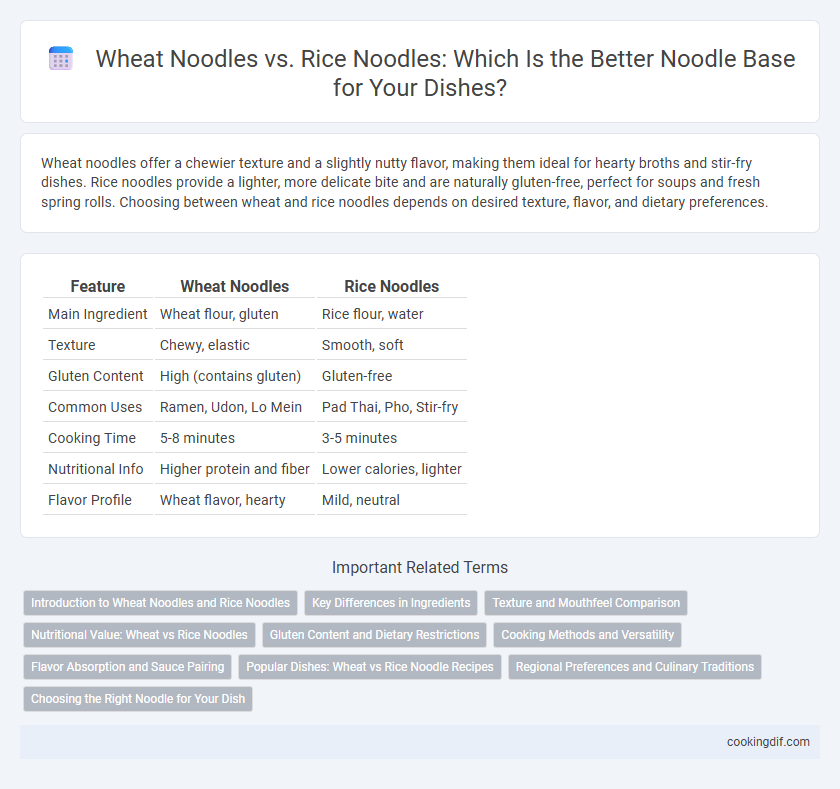Wheat noodles offer a chewier texture and a slightly nutty flavor, making them ideal for hearty broths and stir-fry dishes. Rice noodles provide a lighter, more delicate bite and are naturally gluten-free, perfect for soups and fresh spring rolls. Choosing between wheat and rice noodles depends on desired texture, flavor, and dietary preferences.
Table of Comparison
| Feature | Wheat Noodles | Rice Noodles |
|---|---|---|
| Main Ingredient | Wheat flour, gluten | Rice flour, water |
| Texture | Chewy, elastic | Smooth, soft |
| Gluten Content | High (contains gluten) | Gluten-free |
| Common Uses | Ramen, Udon, Lo Mein | Pad Thai, Pho, Stir-fry |
| Cooking Time | 5-8 minutes | 3-5 minutes |
| Nutritional Info | Higher protein and fiber | Lower calories, lighter |
| Flavor Profile | Wheat flavor, hearty | Mild, neutral |
Introduction to Wheat Noodles and Rice Noodles
Wheat noodles, made from wheat flour and water, offer a chewy texture and robust flavor, commonly used in dishes like ramen and lo mein. Rice noodles, derived from rice flour and water, provide a lighter, more delicate taste with a smooth texture ideal for pho and pad thai. Both noodle bases serve distinct culinary purposes, catering to diverse taste preferences and cultural recipes.
Key Differences in Ingredients
Wheat noodles are primarily made from wheat flour and water, often including eggs, which gives them a firm texture and a slightly nutty flavor. Rice noodles are made from rice flour and water, resulting in a lighter, more translucent noodle with a softer, chewier consistency. The gluten content in wheat noodles provides elasticity, while rice noodles are gluten-free, making them suitable for gluten-sensitive diets.
Texture and Mouthfeel Comparison
Wheat noodles offer a firm, chewy texture due to their gluten content, providing a satisfying bite and elasticity that holds up well in hot soups and stir-fries. Rice noodles feature a softer, smoother mouthfeel with a delicate tenderness and slightly slippery surface, making them ideal for lighter, broth-based dishes or cold salads. The contrast in texture and mouthfeel between wheat and rice noodles significantly influences the overall eating experience and pairing with sauces or ingredients.
Nutritional Value: Wheat vs Rice Noodles
Wheat noodles contain higher protein and fiber levels than rice noodles, supporting muscle growth and digestive health. Rice noodles are lower in calories and fat, making them a lighter option suitable for gluten-free diets. Both noodle types provide essential carbohydrates for energy, but wheat noodles offer more B vitamins and minerals like iron and magnesium.
Gluten Content and Dietary Restrictions
Wheat noodles contain gluten, making them unsuitable for individuals with celiac disease or gluten intolerance, while rice noodles are naturally gluten-free and ideal for gluten-sensitive diets. The higher protein content in wheat noodles provides a chewier texture, whereas rice noodles offer a lighter, more delicate bite. Choosing between wheat and rice noodles depends heavily on dietary restrictions and texture preferences for the noodle base in various culinary applications.
Cooking Methods and Versatility
Wheat noodles offer a chewy texture and hold up well to boiling, stir-frying, and baking, making them ideal for hearty dishes like ramen and lo mein. Rice noodles, made from rice flour and water, cook quickly and absorb flavors efficiently, commonly used in soups, spring rolls, and stir-fries for a lighter, gluten-free option. Both noodle types adapt to diverse cooking methods, with wheat noodles excelling in thicker sauces and rice noodles favored in broths and fresh preparations.
Flavor Absorption and Sauce Pairing
Wheat noodles feature a denser texture and slightly nutty flavor, making them ideal for thick, savory sauces like soy-based or peanut sauces that cling well to their surface. Rice noodles offer a lighter, more delicate profile, perfect for absorbing subtle, aromatic broths and lighter sauces such as fish sauce or lemongrass-infused dressings. Choosing between wheat and rice noodles depends on the desired sauce intensity and flavor integration in the dish.
Popular Dishes: Wheat vs Rice Noodle Recipes
Wheat noodles, known for their chewy texture, are essential in popular dishes like ramen, udon, and lo mein, offering robust flavor absorption and versatility. Rice noodles, prized for their light and silky texture, feature prominently in pho, pad thai, and Singaporean rice noodle stir-fries, complementing vibrant broths and bold seasonings. Both noodle types serve as versatile bases tailored to distinct culinary traditions, enhancing specific flavor profiles and cooking methods.
Regional Preferences and Culinary Traditions
Wheat noodles dominate Northern Chinese cuisine, prized for their chewy texture and robust flavor, while rice noodles are a staple in Southern China and Southeast Asia, favored for their delicate, light consistency. Regional preferences reflect climatic and agricultural conditions, with wheat grown primarily in northern regions and rice cultivated extensively in southern areas. Culinary traditions shape noodle use, as wheat noodles often appear in hearty broths and stir-fries, whereas rice noodles are integral to fresh, aromatic dishes like pho and pad thai.
Choosing the Right Noodle for Your Dish
Wheat noodles offer a chewy texture and a robust flavor ideal for hearty dishes like ramen and stir-fries, while rice noodles provide a lighter, gluten-free option that absorbs sauces well, perfect for dishes like pad thai and pho. The protein content in wheat noodles enhances their elasticity, making them suitable for dishes requiring a denser noodle base, whereas rice noodles are favored in lighter broths and salads due to their delicate texture. Selecting between wheat and rice noodles depends on the dish's flavor profile, desired texture, and dietary restrictions such as gluten intolerance.
Wheat noodles vs Rice noodles for noodle base Infographic

 cookingdif.com
cookingdif.com